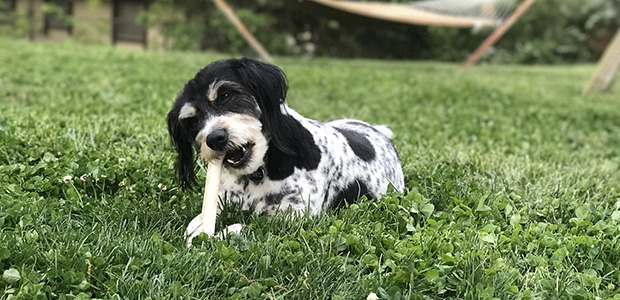What is positive reinforcement (+R)?
First Published: 26/02/2020
Last Updated: 23/11/2023
Are you about to train your new puppy or kitten?
Do you often hear the phrase ‘positive reinforcement’ floating around and wonder what it means?
Let’s take a closer look.
Define ‘positive reinforcement’
In most subjects, ‘positive’ and ‘negative’ have emotional connotations. In behavioural training however, their meanings are more mathematical. ‘Positive’ means ‘adding something’, while ‘negative’ means ‘taking something away’.
‘Reinforcement’ refers, in this context, to the successful continuation of behaviour.
So ‘positive reinforcement’ = adding something positive to the dog’s environment that results in them successfully continuing with a particular behaviour.
Positive and negative reinforcement – what’s the difference?
Negative reinforcement means taking away something the animal finds unpleasant, in order for them to continue with a certain behaviour.
This is not to be confused with punishment – the aim of which is to discourage a pet from a particular behaviour. Just like with reinforcement, punishment can be both positive and negative (technically speaking).
Shorthand:
Positive reinforcement: +R
Negative reinforcement: -R
Positive punishment: +P
Negative punishment: -P
Positive reinforcement examples
The most obvious example is… treats. Rewarding good behaviour with a small treat is the quickest and most effective method of letting your pet know that what they just did was good, and that they should do it again in future.
Treats come in useful when teaching basic commands, such as sit, lie down, speak, roll over and stay, but they’re not the only rewards out there. Every dog is different: some may respond to toys and playtime more than treats, others might respond to praise and attention.
It’s important to acknowledge that positive reinforcement cannot exist without negative punishment. For example, when training a dog to heel… giving them treats when they’re successful would count as positive reinforcement, while withholding treats when they’re unsuccessful would count as negative punishment.
This method is generally preferable to negative reinforcement and positive punishment. (An example of this would be teaching them to heel using a choke collar: the dog is punished for pulling ahead, and not punished for walking normally.)

Should I ever shout at my dog?
Shouting at your dog is a common example of positive punishment, and it can often be effective at stopping bad behaviour there and then.
However, positive punishment is not recommended because it simply suppresses bad behaviour without addressing the animal’s underlying motivation. Too much positive punishment may make the pet less inclined to trust their owner, and sever the bond between them.
What about when their behaviour is destructive?
If your dog’s behaviour is causing damage to your furniture (scratching the skirting boards etc.), try distracting them rather than punishing them.
Say ‘AH!’ in an abrupt voice, then get them to do some work – a few tricks will do. Once they’ve worked successfully, reward them with play time or with a treat. This way, rather than punishing negative behaviour outright, or accidently rewarding it by playing with them straight away, you offer your dog something other than negative behaviour to focus on, and then reward them for their cooperation.
Preventing destructive behaviour
It's one thing to stop destructive behaviour there and then, but your main goal as an owner should be to prevent it. When training your dog, make sure the environment is set up in their favour; the space should be cleared of distractions and things they shouldn’t chew. Likewise, have it full of things they should chew. These exercises will reduce the chance of bad behaviour occurring in the first place.
And remember, if you find that you’re struggling with your dog’s behaviour, you may need to consult a qualified behaviourist.
Need more info?
For more help and advice on training your pet, or any aspect of their behaviour, have a chat with your local vet.
Find your nearest vet using our Find a Vet page, or speak to a vet online using Online Vets.


